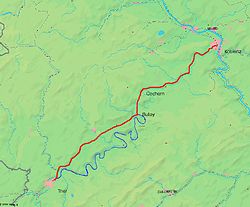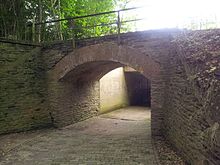Moselle Railway
As Moselbahn (also Moseltalbahn ), the decommissioned on 31 December 1962 the right of the Mosel situated 102 kilometers Small railway line from Trier to Bullay referred to the former Moselbahn AG belonged.
history
The connection from Koblenz to Trier ( Moselle route ), which was opened in 1878/79 and is mainly located to the left of the Moselle, does not run through the Moselle valley between Trier and Bullay, but takes a shorter route through the Vordereifel , so that the towns of Bernkastel-Kues and Traben- Trarbach had to be connected to the rail network by branch lines built in 1883. The rest of the villages in the Moselle valley remained without a rail connection for the time being, although there was already a traffic interest due to viticulture and the emerging tourism.
After years of planning, which initially provided for a narrow-gauge railway, some banks and the West German Railway Company (WeEG) finally founded the Moselbahn AG in Cologne on April 12, 1899 . WeEG and its successors - Vereinigte Kleinbahnen AG and Deutsche Eisenbahn-Gesellschaft - took over the management, which also included the Philippsheim – Binsfeld small railway in the Eifel. In the 1920s, the AG for Transport (AGV) acquired the majority of the shares, in 1940 it was almost 95%. AGV sold these shares to the State of Rhineland-Palatinate in 1962 .
The first construction work began in the spring of 1900, initially as a meter-gauge railway. Since the Moselbahn agreed to bear the additional costs of standard-gauge expansion, the standard-gauge construction was decided. The military in particular had spoken out in favor of it, so the use of the route in times of war as a diversion route was already included in the license. On April 2, 1903, operations began from Trier , where the terminus in front of the state train station was on the road, to Leiwen. An opening ceremony did not take place until May 28, 1903, when the trains could continue to Niederemmel. At the end of the year, on December 29, 1903, the rail line had reached the Andel train station (now part of Bernkastel-Kues ), where the center of operations was created. Only on March 15, 1904 was the drive to Bernkastel and on August 19, 1905 the last section to Bullay was completed. Only here and in Ruwer existed track connections to the state railway. However, the construction of the railway was much more expensive than planned, so that in addition to the initial 6 million Reichsmarks from the Moselle Railway, a total of another 10 million Reichsmarks had to be raised.
The Kleinbahn had 38 stations with numerous station buildings of different sizes and equipment, also in places that were touched by the state railway. Some state railway stations on the Moselle route still carry the name affix "Reichsbahn" or "DB" for "German (Federal) Railway" introduced to differentiate them. B. " Schweich (DB) ", because there was also a small train station for the same place. These stations then bore the suffix “Kleinbahn” (1914 and 1927), “Moselle Valley Railway” (1939) and, from around 1943, North, East, South or West.
Since the Moselle Valley Railway ran through many well-known wine-growing locations on the Moselle, including Bernkastel , Trarbach and Zell , it was also popularly known as "Saufbähnchen" - wine was even served on the trains as a tourist attraction, with the corresponding consequences for the mood of the passengers which Kurt Tucholsky described with a wink in 1930.
The trains were also called “little trains” because they were a relatively slow means of transport: the four-hour journey along the entire route, which lasted four hours in 1905, which corresponds to an average speed of 25 km / h, could only be shortened slightly after fifty years. Even the diesel railcars, which had predominantly been used since the 1950s, were not much faster.
In times of war, Reichsbahn trains were diverted via the Moselle Railway. And when, after the end of the war in 1945, the Moselle line was out of service - almost halfway - due to blown bridges between Trier and Eller, the Moselbahn trains ran from Trier Nord over the entire small railway line to Bullay Reichsbahnhof and one station further to Neef until April 1947, from where the travelers went to a ferry in order to be able to board a train again on the left bank of the Moselle in Eller station. Since there was no continuous track connection from the Moselle Railway to the Reichsbahn tracks in the direction of Neef, the trains had to head twice in the Bullay station area.
On June 10, 1951, there was a serious railway accident at a level crossing near Kenn . 15 people died, 20 others were seriously injured and 13 were slightly injured when a train collided with a railroad bus on an open level crossing .
Shutdown
After the currency reform, rising costs and very low fares led to financial difficulties. In addition, the floods in 1955 caused high costs for the restoration of the line. As early as 1957, an application for closure of the entire route was submitted, but this was not granted. Instead, the state of Rhineland-Palatinate stepped in with financial contributions, but without initiating a thorough modernization of the route. Although the state of Rhineland-Palatinate had meanwhile become almost one hundred percent shareholder of Moselbahn AG, the line was finally shut down gradually between 1961 and 1968 - against the resistance of the population. It began on September 30, 1961 with the suspension of passenger traffic on the section from Bullay to Traben-Trarbach, which was then followed on December 31, 1962 by the subsequent route to Niederemmel-Piesport, on which freight traffic from Bullay also ceased.
On May 22nd, 1966 all traffic between Niederemmel-Piesport and Neumagen-Dhron ended. The multiple units on the remaining route to Trier have now been brought into the main train station there. But since February 1, 1968, traffic was still here too; only the freight traffic between Ruwer West and Trier was maintained for a few years. The railway tracks of the Moselle Railway that have remained along Metternichstraße in Trier Nord to this day, with their numerous branches, served as industrial tracks that connected the district with the Moselle route and the Hochwaldbahn until the 1980s . In Bullay Süd, too, the siding to the Raiffeisen warehouse was still served - albeit by the Deutsche Bundesbahn.
The dismantling of the small railroad enabled better access to the river in some communities and the construction or widening of riverside roads. On the other hand, the Moselle valley lost a special attraction for tourism with the small train. It is particularly noteworthy that the Moselle Railway itself removed the tracks. These were used in coal mining in North Rhine-Westphalia.
Current condition
A large part of the route was converted into a cycle path. With the exception of a few representative station buildings (for example in Bernkastel-Kues , Trier-Ruwer or Köwerich ), almost nothing of the line has survived. The tracks of the Moselle Railway (4.6 km in length) that have remained along Metternichstraße, Am Grüneberg and Ruwerer Straße in Trier to this day , with their numerous branches, served as industrial tracks connecting the districts of Trier-Ruwer and Trier-Nord until the 1990s connected with the Moselle route and the Hochwaldbahn .
In Bullay there is also an old section of track of around ten meters left, it is located directly on the main street in the underpass near the “Alter Bahnhof” inn. In Neumagen-Drohn, two more remnants have been preserved north of the former train station. In many places there is still a Bahnhofstrasse, although there is no longer a train station far and wide. Also in the course of the Kürenzer Straße at the Trier main station there is still an old track of the Moselle Railway, which was partly tarred and is still in the pavement.
vehicles
When it opened, the Moselbahn had two four-axle Mallet locomotives from Hohenzollern (locomotives 1 and 2), the first of which was named MOSEL, and four double-coupled locomotives with leading axles from Humboldt (locomotives 3 to 6). The two Mallet locomotives and two of the Humboldt machines always stayed on the Moselle Railway. Locomotive 5 came to Guhrauer Kreisbahn AG via the Teutoburg Forest Railway . So it came to the Deutsche Reichsbahn, where it was hardly used, but was given the number 70 6401. Locomotive 6 was in service with another WeEG railway from 1909 to 1916 , after its return it was number 10. In 1905, a used two-axle locomotive was briefly added (locomotive 7), as was a brand new locomotive identical to the Humboldt locomotives (loc 8) and another Mallet locomotive that was previously in service with the Filderbahn (locomotive 9).
In 1909 two locomotives were exchanged for three lighter ones in order to reduce operating costs. One of the new locomotives was from the Braunschweig-Schöninger Eisenbahn (locomotive 7 II ), the other two were brand new from the Esslingen machine factory with Kittel standing boilers (locomotives 6 II and 10).
1936/1937 the Moselbahn received three railcars from the wagon factory Wismar by type Mosel . In 1951 two of these railcars had an accident and had to be retired. In 1952, a used railcar of the same type was added as a replacement. Another used double railcar came from the Farge-Vegesacker Railway . In 1952 and 1955, a total of three Esslingen railcars were acquired.
literature
- Moselbahn-Gesellschaft mbH, Trier: lifeline of a landscape; Review and present report on the 70th anniversary. Trier 1972.
- Moselbahn-Gesellschaft mbH, Trier: Moselle Valley Railway Trier-Bullay: 1905–1980. Festschrift on the occasion of the 75th anniversary. Trier 1980.
- Karl-Josef Gilles : The Moselle Valley Railway. The 'drinking bout' . Sutton Verlag, Erfurt 2009, ISBN 978-3-86680-467-8 .
- Kurt Hoppstädter: The railways in the Moselle valley according to the files of the Koblenz State Archives. Publisher: Bundesbahndirektion. Saarbrücken 1973.
- Ludger Kenning, Manfred Simon: The Moselle Railway Trier-Bullay . Kenning Verlag, Nordhorn 2005, ISBN 3-927587-36-2 .
- Sebastian Schnitzius: Development of the railway in the Trier area. Booklet for the 2000 year celebration of Triers. Publisher: Dt. Federal railway station Trier Hbf, Trier 1984.
- Gerd Wolff: German small and private railways. Volume 1: Rhineland-Palatinate / Saarland . Eisenbahn-Kurier, Freiburg 1989, ISBN 3-88255-651-X , p. 76-112 .
- Jürgen Munzar: Memories of the Moselle Valley Railway . In: Wolfgang Messerschmidt (Ed.): Locomotive magazine . No. 69 . Franckh'sche Verlagshandlung, W. Keller & Co. , 1974, ISSN 0458-1822 , p. 467-475 .
- Moselle Valley Railway. From Trier to Bullay. Travel Guide. Published by Schaar & Dathe. Trier 1925.
- Moselle Valley Railway Trier-Bernkastel-Bullay. Trier 1907.
See also
Web links
- The Mosel (valley) railway. Retrieved December 19, 2010 .
- Track plans of the stations of the Moselbahn
- Route Enkirch-Mülheim (measuring table sheet from 1914)
- Route Wintrich-Detzem (measuring table sheet from 1914)
- Route Enkirch-Pölich (Map 1: 100,000 from 1909)
Individual evidence
- ↑ Railway Atlas Germany . 9th edition. Schweers + Wall, Aachen 2014, ISBN 978-3-89494-145-1 .
- ↑ Ignaz Wrobel (= Kurt Tucholsky): Monument at the Deutsches Eck, 1930: http://www.textlog.de/tucholsky-denkmal-deutschen.html
- ↑ a b Löttgers, Rolf: private railways in Germany: The German railway company 1960-1969, Stuttgart 1983, p 48







